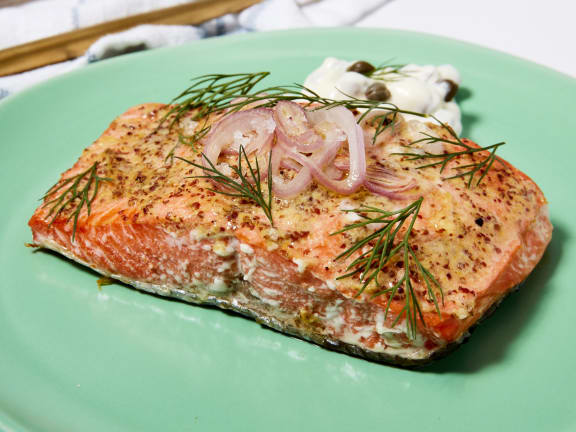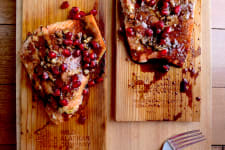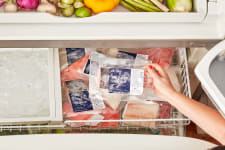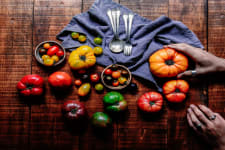When cooking salmon, you may notice the formation of white stuff on the surface of the fish, especially when you are using very hot cooking methods like pan-searing, grilling, or broiling. This white stuff on salmon is a protein known as albumin.
Albumin can form on white fish as well as land-based meats. However, it is especially noticeable when it forms on salmon, due to the contrast of the white albumin against the pink or red color of salmon.
What Is Albumin?
Albumin is a flavorless, moisture-rich protein that collects on the surface of salmon as it cooks. It is completely natural and a normal part of the salmon cooking process. Albumin is safe to eat.
We can’t see albumin in raw salmon, but it becomes visible as the fish is exposed to heat. As the fish cooks, its structure begins to contract, pushing the moisture-filled albumin to the surface of the fish. The albumin then shows up as a milky coating on the salmon.
Albumin can indicate how much moisture is left in cooked salmon. A small amount of albumin is normal, as fish naturally expels some moisture as it cooks. However, when you see lots of albumin on the surface, it can suggest that the fish has lost a significant amount of moisture during the cooking process.
Different cuts of salmon, such as skinless fillets, ground or minced salmon, or salmon burgers, can be more susceptible to albumin formation. Salmon burgers, for example, contain smaller pieces of fish that naturally are more exposed to heat than a full fillet. And since they’re usually cooked over a hot grill, salmon burgers are even more likely to produce a significant amount of albumin as they cook.
How to Avoid Albumin on Salmon
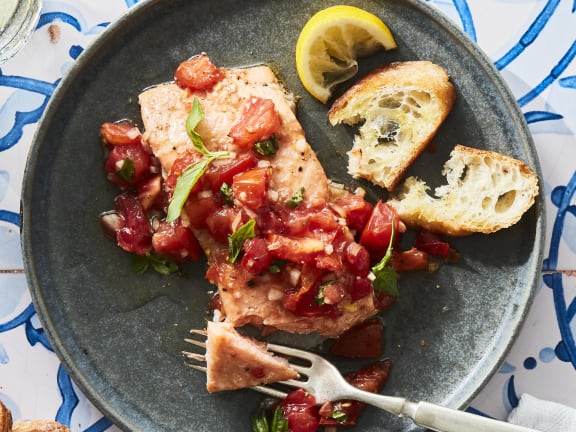
While albumin won’t affect the flavor of your meal, you may prefer to avoid it when cooking salmon. Different techniques can help reduce the white stuff on salmon while leaving the fish more tender and moist.
There are a lot of easy ways to prevent albumin from forming on salmon, like knowing when your wild salmon is done cooking, gentle cooking, marinades, and more. Here are a few ways to reduce albumin:
Adjust Your Cook Times
With the right cooking times, you can limit the formation of white stuff on wild salmon and make your dish look as incredible as it tastes. Because it’s so lean, wild salmon is easy to overcook and thus more likely to produce albumin. Additionally, most recipe cook times cater to farmed salmon, so if you’re following a recipe that doesn’t specify cook times for wild fish, you’ll need to make some adjustments.
For a moist and flaky medium-rare fillet, you should aim for an internal temperature of 120 degrees F. Medium-rare salmon flakes off into large, tender chunks with the touch of a fork.
If you enjoy your salmon well-done, the internal temperature should rest at 145 degrees F. You will likely notice, though, that well-done salmon tends to have more albumin on the surface, since more moisture has been cooked out of the fish.
For ground sockeye salmon or salmon burgers, there’s more of a chance that albumin will form on the fish, since the proteins have more direct exposure to the heat. While you may not be able to completely prevent the white stuff from forming, you can still help the fish retain its moisture by cooking it until it’s just opaque, or about medium-done. 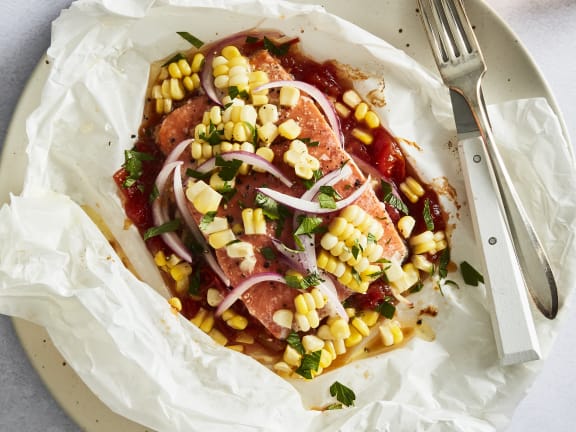
Gentle Handling and Cooking
Reducing albumin on salmon isn’t all about overcooking. There are plenty of other factors, like gentle handling while cooking, that can help the fish retain moisture while preparing your meal. Gentle cooking methods like poaching, steaming in a pouch, or baking at a low temperature can go a long way in preventing albumin from forming. These are great techniques to use when cooking fillet portions.
Use a Salt Brine
A saltwater brine can help reduce the formation of albumin. If you have a little extra time to prep your meal, mix together a simple saltwater brine by dissolving 1 tablespoon of salt in 1 cup of cool water. Submerge your salmon fillets in this saltwater solution for about 10 to 15 minutes, then pat the fish dry before cooking. Keep in mind that the brine will have seasoned the fish already, so you don't need to add any more salt.
Use a Marinade
Marinades can help keep in the moisture of your salmon while also adding color and flavor to your dish. The salt and moisture in a marinade serve as a protective barrier that minimizes the formation of albumin on the surface of the fish. This can be especially helpful for recipes that require grilling, broiling, or baking at high temperatures.
Cook Salmon With the Skin On
Leaving the skin on your salmon while you cook also protects your salmon from drying out, and will consistently leave you with a perfect, tender fillet. That’s because many of the fats in a fillet of wild salmon are stored in the skin. These fats help buffer the heat of your cooking source, whether you're grilling, searing, or broiling. Salmon skin can easily be removed once the fillet is cooked, depending on your preference.
Albumin Removal
Whether you’re cooking fillets or burgers, the white stuff on salmon is very easy to remove. Before serving the salmon, you can wipe off the albumin with a napkin or kitchen towel, or scrape it off with a utensil. The albumin can then be discarded.
Perfecting Your Bake
Baking wild salmon is one of the most common ways to prepare it. When using lower temperatures, it’s also a gentler way of cooking salmon than broiling, grilling, or searing. Visit WAC’s comprehensive guide to cooking wild salmon so that you can master your bake and never have dry salmon again.
Try these recipes when you want to avoid albumin on salmon:
